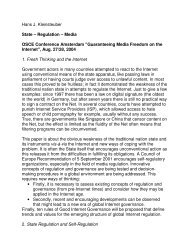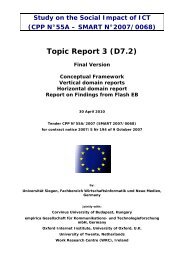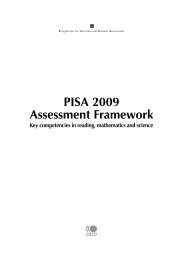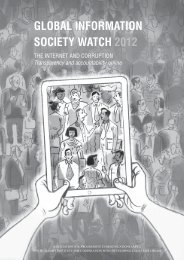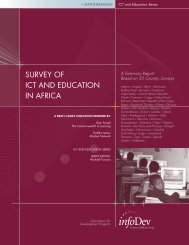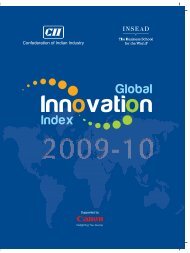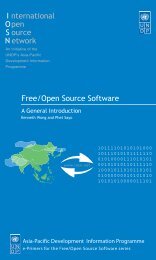Annex A. Localization – Key Concepts ❘ 27Input MethodsThere are many factors in the design and implementation of input methods. The more different thecharacter set size and the input device capability are, the more complicated the input method becomes.For example, inputting English characters with a 104-key keyboard is straightforward (mostly one-toone– that is, one key stroke produces one character), while inputting English with mobile phone keypadrequires some more steps. For languages with huge character sets, such as CJK, character input is verycomplicated, even with PC keyboards.Therefore, analysis and design are important stages of input method creation. The first step is to list allthe characters (not glyphs) needed for input, including digits and punctuation marks. The next step is todecide whether it can be matched one-to-one with the available keys, or whether it needs somecomposing (like European accents) or conversion (like CJK Romanji input) mechanisms in which multiplekey strokes are required to input some characters.When the input scheme is decided for the script, the keyboard layout may be designed. Good keyboardlayout should help users by putting most frequently used characters in the home row, and the rest in theupper and lower rows. If the script has no concept of upper/lower cases (which is almost the case fornon-Latin scripts), rare characters may be put in the shift positions.Then, there are two major steps to implement the input method. First, a map of the keyboard layout iscreated. This is usually an easy step, as there are existing keyboard maps to refer to. Then, if necessary,the second step is to write the input method based on the keyboard map. In general, this means writingan input method module to plug into the system framework.LocalesLocale is a term introduced by the concept of internationalization (I18N), in which generic frameworksare made so that the software can adjust its behaviour to the requirements of different native languages,cultural conventions and coded character sets, without modification or re-compilation.Within such frameworks, locales are defined for describing particular cultures. Users can configure theirsystems to pick up their locales. The programs will load the corresponding predefined locale definition toaccomplish internationalized functions. Therefore, to make internationalized software support a newlanguage or culture, one must create a locale definition and fill up the required information, and thingswill work without having to touch the software code.According to POSIX, 1 a number of C library functions, such as date and time formats, string collation,numerical and monetary formats, are locale-dependent. ISO/IEC 14652 has added more features to POSIXlocale specifications and defined new categories for paper size, measurement unit, address and telephoneformats, and personal names. GNU C library has implemented all of these categories. Thus, culturalconventions may be described through it.Locale definitions are discussed in detail on pages 41-42.TranslationTranslating messages in programs, including menus, dialog boxes, button labels, error messages, and soon, ensures that local users, not familiar with English, can use the software. This task can be accomplishedonly after the input methods, output methods and fonts are done – or the translated messages willbecome useless.There are many message translation frameworks available, but the general concepts are the same.Messages are extracted into a working file to be translated and compiled into a hash table. When theprogram executes, it loads the appropriate translation data as per locale. Then, messages are quicklylooked up for the translation to be used in the user interface.Translation is a labour-intensive task. It takes time to translate a huge number of messages, which is whyit is always done by a group of people. When forming a team, make sure that all members use consistentterminology in all parts of the programs. Therefore it is vital to work together in a forum through close1POSIX is the acronym for Portable Operating System specification
28 ❘ FREE/OPEN SOURCE SOFTWARE: LOCALIZATIONdiscussion and to build the glossary database from the decisions made collectively. Sometimes thetranslator needs to run the program to see the context surrounding the message, in order to find aproper translation. At other times the translator needs to investigate the source code to locate conditionalmessages, such as error messages. Translating each message individually in a literal manner, withoutrunning the program, can often result in incomprehensible outputs.Like other FOSS development activities, translation is a long-term commitment. New messages are usuallyintroduced in every new version. Even though all messages have been completed in the current version,it is necessary to check for new messages before the next release. There is usually a string <strong>free</strong>ze periodbefore a version is released, when no new strings are allowed in the code base, and an appropriate timeperiod is allocated for the translators. Technical aspects of the message translation process are discussedon page 45.GNU/Linux Desktop StructureBefore planning to enable a language in GNU/Linux desktop, a clear understanding of the overview of itsstructure is required. GNU/Linux desktop is composed of layers of subsystems working on top of one another.Every layer has its own locale-dependent operations. Therefore, to enable a language completely, it isnecessary to work in all layers. The layers, from the bottom up, are as follow (See Figure 1):1.2.3.The C Library. C is the programming language of the lowest level for developing GNU/Linuxapplications. Other languages rely on the C library to make calls to the operating system kernel.The X Window. In most UNIX systems, the graphical environment is provided by the X Windowsystem. It is a client-server system, where X clients make requests to X server and receive eventsfrom it across the network connection (or through a local inter-process communication channel)based on X protocol. A library called X Library (Xlib) encapsulates this protocol by a set ofapplication programming interfaces (API), so that X clients can do everything in terms of functioncalls. Due to its liberal license terms, which allow even commercial redistributions, there havebeen several versions of X Window in the UNIX market. For GNU/Linux, XFree86 is the majorcode base, although new releases of some major distributions are now migrating to the newlyforked X.org released in April 2004. All forks differ mainly in X server implementation and someextensions. But the X protocol and Xlib function calls are still standardized.Toolkits. Writing programs using the low-level Xlib can be tedious as well as a source ofinconsistent GUI when all applications draw menus and buttons by their own preferences. SomeFigure 1GNU/Linux Desktop Structure and Internationalization



